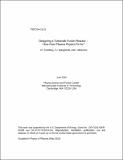Designing a tokamak fusion reactor—How does plasma physics fit in?
Author(s)
Mangiarotti, Franco Julio; Minervini, Joseph V; Freidberg, Jeffrey P.
DownloadDesigning a tokamak.pdf (703.7Kb)
PUBLISHER_POLICY
Publisher Policy
Article is made available in accordance with the publisher's policy and may be subject to US copyright law. Please refer to the publisher's site for terms of use.
Terms of use
Metadata
Show full item recordAbstract
This paper attempts to bridge the gap between tokamak reactor design and plasma physics. The analysis demonstrates that the overall design of a tokamak fusion reactor is determined almost entirely by the constraints imposed by nuclear physics and fusion engineering. Virtually, no plasma physics is required to determine the main design parameters of a reactor: a, R[subscript 0], B[subscript 0], T[subscript i], T[subscript e], p, n, τ[subscript E], I. The one exception is the value of the toroidal current I, which depends upon a combination of engineering and plasma physics. This exception, however, ultimately has a major impact on the feasibility of an attractive tokamak reactor. The analysis shows that the engineering/nuclear physics design makes demands on the plasma physics that must be satisfied in order to generate power. These demands are substituted into the well-known operational constraints arising in tokamak physics: the Troyon limit, Greenwald limit, kink stability limit, and bootstrap fraction limit. Unfortunately, a tokamak reactor designed on the basis of standard engineering and nuclear physics constraints does not scale to a reactor. Too much current is required to achieve the necessary confinement time for ignition. The combination of achievable bootstrap current plus current drive is not sufficient to generate the current demanded by the engineering design. Several possible solutions are discussed in detail involving advances in plasma physics or engineering. The main contribution of the present work is to demonstrate that the basic reactor design and its plasma physics consequences can be determined simply and analytically. The analysis thus provides a crisp, compact, logical framework that will hopefully lead to improved physical intuition for connecting plasma physic to tokamak reactor design.
Date issued
2015-07Department
Massachusetts Institute of Technology. Department of Nuclear Science and Engineering; Massachusetts Institute of Technology. Plasma Science and Fusion CenterJournal
Physics of Plasmas
Publisher
American Institute of Physics (AIP)
Citation
Freidberg, J. P. et al. “Designing a Tokamak Fusion reactor—How Does Plasma Physics Fit In?” Physics of Plasmas 22, 7 (July 2015): 070901 © 2015 AIP Publishing
Version: Author's final manuscript
ISSN
1070-664X
1089-7674